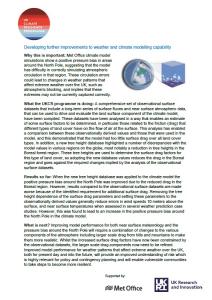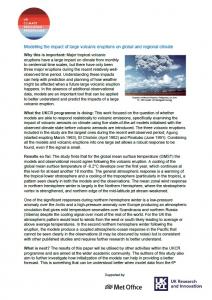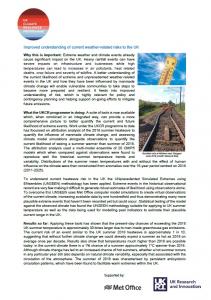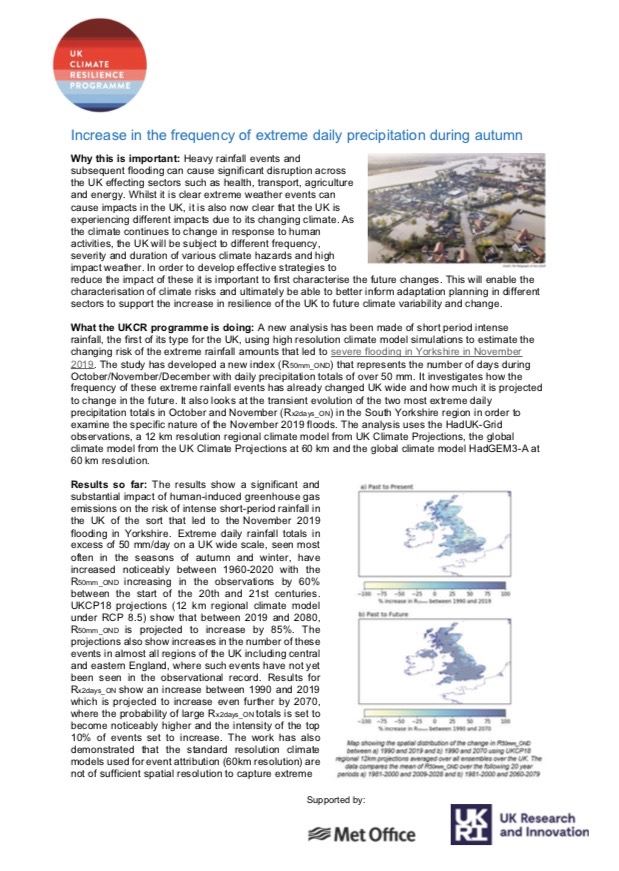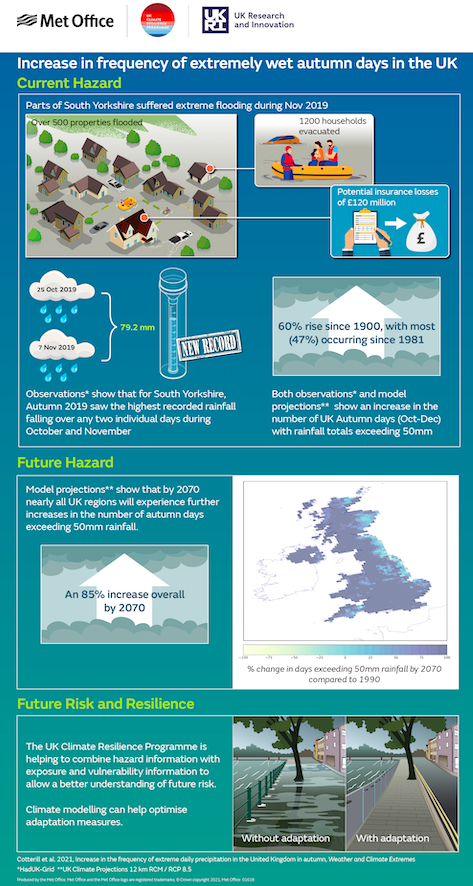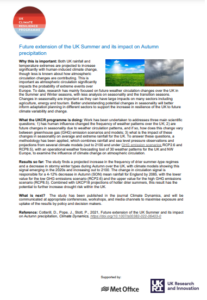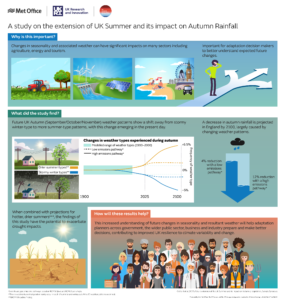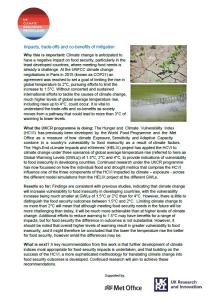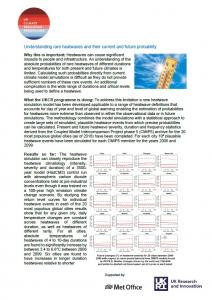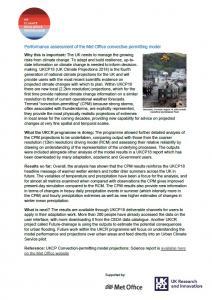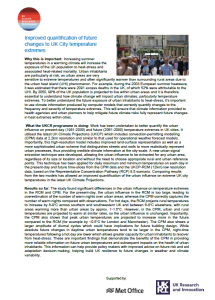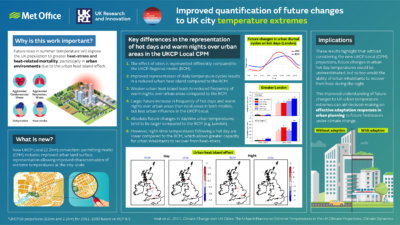Many of the projects in this work package now have initial outputs available – these have been added below under each project.
This Met Office work package focuses on improving climate hazard information, viewed in the context of being able to use the information as part of quantifying climate risks. Firstly, there is research focusing on comparing different approaches to estimating the probability of extreme events in the recent past, notably using data from UKCP18, UNSEEN and event attribution approaches. We will also seek to extend event attribution to impact relevant metrics. Further assessment of changes in the new high resolution 2.2km scale UKCP dataset will be carried out, including assessing changes in lightning, hail, wind, and urban temperature extremes. Additional work to understand larger future increases in winter mean precipitation in the 2.2km compared to the 12km dataset will also be carried out, including diagnosing the convective contribution to this difference. Future changes in heatwaves of 2 to 16 days duration using conditional non-stationary extreme approaches will be applied. New approaches to estimating the spatial variation of extreme behaviour will be applied to the UK for wind, precipitation and temperature.
This research will focus on:
- Assembling useable outputs (knowledge and datasets) from existing scientific methods to quantify hazards in terms of climate metrics on a range of timescales from present day.
- Assessing the different types of hazard quantification methodologies including where they overlap in terms of timescale or addressing a level of risk aversion in order to produce guidance and tools on choice of methodology for different situations
- Extending and combining existing methodologies to cover gaps in timescale or risk-aversion levels needed for the hazard component of risk assessment
- Extending the hazard quantification tools into metrics more relevant to impacts of people, infrastructure and the natural environment of the UK.
The resulting data will be available for use in other Met Office work packages on risk and climate service development, including outside of this SPF programme, and other UKRI SPF Climate risk projects.
The work is split into the following activities:
a. Impact event attribution (Met Office led)
This project aims to improve techniques for hazard quantification for use in climate-risk estimation. It will make use of tools employed in event attribution, but with a greater focus on impact and adaptation related metrics.
The research is currently looking at the impact of climate change on flooding in the UK through heavy rainfall events: whether heavy precipitation events are becoming more regular in the UK, particularly in Autumn, such as the rainfall in the Sheffield area in 2019 which caused the River Don to burst its banks, causing widespread flooding.
OUTPUTS from this project are available on the following topics (click thumbnails below to read):
- Developing further improvements to weather and climate modelling capability (PDF summary)
- Modelling the impact of large volcanic eruptions on global and regional climate (PDF summary)
- Improved understanding of current weather-related risks to the UK (PDF summary)
- Increase in the frequency of extreme daily precipitation during autumn (PDF summary)
- Future extension of the UK Summer and its impact on Autumn precipitation (PDF summary and infographic)
- Future summers could last longer hints Met Office research (Met Office blog, 30 Aug 2022)
- Publication: Cotterill, D.F., Pope, J.O. and Stott, P.A. 2022. Future extension of the UK summer and its impact on autumn precipitation. Climate Dynamics.
- Publication: Cotterill, D., Stott, P., Christidis, N., Kendon, E., 2021. Increase in the frequency of extreme daily precipitation in the United Kingdom in autumn. Weather and Climate Extremes. 33.
b. Application of statistical extreme value approaches to UK climate data (Met Office led)
This project aims to extend extreme value approaches to temperature, rainfall and wind over UK and a general statistical framework for comparing and combining extreme value methods and larger ensembles.
Initial work focussed on temperature using CMIP data. In collaboration with Newcastle University and Exeter University the Met Office have begun applying new methods for deriving extreme value distributions that are coherent spatially, and dependent on location attributes such as elevation and surface roughness. Provisional analyses have derived 100-year return levels for gusts using elevation and distance to coast as covariates in the spatial model.
Work is now centred on constructing appropriate structure for the spatial models; identifying key covariates for spatial modelling; application to station rainfall and defining suitable validation approaches.
OUTPUTS from this project are available on the following topics (click thumbnails below to read):
- Impacts, trade-offs and co-benefits of mitigation (PDF summary)
- Understanding rare heatwaves and their current and future probability (PDF summary)
- Publication: Keat, W., Kendon, E. & Bohenstengel, S., 2021. Climate change over UK cities: the urban influence on extreme temperatures in the UK climate projections. Climate Dynamics.
- Webinar: 23 September 2020: Statistical analysis and attribution of impact relevant climate extremes with Simon Brown and Daniel Cotterill (Met Office). Part 1, part 2, part 3 and part 4.
c. Further assessment of UKCP18 CPM results over the UK (Met Office led)
This work package aims to increase understanding of the robustness of the extreme events and mean climate change from the convective permitting model. This is part of the over-arching goal of robust characterisation, quantification and communication of climate-related risks).
Following the completion of a report on convective permitting model performance, work is now focusing on the representation of urban processes in the UKCP 2.2km ensemble compared to the 12km RCM, and implications of this for future projections over cities. This will initially look at the representation of the urban heat island, temperature extremes and the diurnal cycle of temperature. There are also plans to look at the triggering and evolution of convection over cities.
OUTPUTS from this project are available on the following topics (click thumbnails below to read):
- Performance assessment of the Met Office convective permitting model (PDF summary)
- Improved quantification of future changes to UK city temperature extremes (pdf summary and infographic)
d. Linking to the national Climate Change Risk Assessment (CCRA) process and synthesis of SPF resilience projects (Met Office led)
This part of the funding is being used to ensure consistency with the CCRA3 and proper co-development of science.
There has been a lot of progress made quantifying impacts on natural capital, both for a standard scenario of ongoing climate change and also on the economic impacts of a shutdown of the thermohaline circulation based on the UKCP18 projections. This is a key piece of analysis that will feed into the urgency scores for the natural environment risks and opportunities and the wider economic analysis work. Discussions are ongoing as to how to ensure SPF UK Climate Resilience Programme work adequately feeds into CCRA3, including covering issues of peer review.
OUTPUTS While there are no project specific reports available, the reports produced for the other projects in this work package contribute to this long-running project.
e. Knowledge integration and development of communications materials (Met Office led)
This activity helps the Met Office to communicate the outputs from their work on the SPF UK Climate Resilience. The Met Office Hadley Centre is in the process of producing the briefing notes, user case studies and power point slides to support knowledge translation and communication tools using the principles of knowledge integration established at the Met Office for use in the UK Climate Resilience Programme. This will also contribute to joint synthesis activities.
OUTPUTS While there are no project specific reports available, the reports produced for the other projects in this work package contribute to this long-running project.
f. Digitization of observations (University of Reading and Clive Wilkinson)
Suitable observation data is a key ingredient to hazard and risk assessment. This activity scanned and digitised additional historical observations, which were previously available only in their original paper format. An element of the project was to use the Weather Rescue project led by University of Reading, and a site was launched for British Science Week on 8th March. Data has been recovered for 1861-1875.
OUTPUTS from this project are available on the following topics (click thumbnail below to read):
- Improved understanding of weather and climate events through data rescue (PDF summary)
- Publication: Craig, P.M. and Hawkins, E. 2020. Digitizing observations from the Met Office Daily Weather Reports for 1900-1910 using citizen scientist volunteers. Geoscience Data Journal.
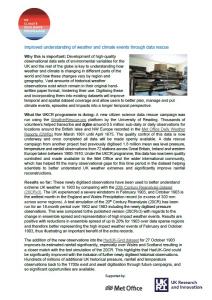
Image of the “Beast from the East”, York Minster (Unsplash)


